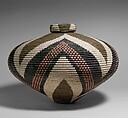Lidded Basket
Beauty Ngxongo South African
Not on view
This lidded basket is an outstanding example of an important form of expression from South Africa's rural Kwazulu-Natal region. Grasses and grasslike plants are readily available natural resources in the Kwazulu-Natal region that the Zulu have incorporated into many domestic artifacts, including floor mats, spoon holders, and various kinds of baskets such as this example from the Museum's collection. The origins of the weaving tradition remain unknown, but European accounts describe the use of grass and related plants by the Zulu as early as the sixteenth and seventeenth centuries.
Baskets historically served as utilitarian containers in everyday Zulu life that were usually decorated with very simple designs or left completely devoid of ornament. Recently, individual weavers who create artifacts for the art market as well as for everyday use have introduced complex designs and color schemes to the tradition of basket weaving. This basket is a superb example of the work of one of southern Africa's preeminent contemporary weavers who has blurred the line between utilitarian craft and fine art. Its creator, Beauty Nxgongo, is nationally known for her distinctive baskets with vibrant designs. Though strongly rooted in the weaving tradition of southern Africa, Nxgongo's work is created for art's sake and praised for its aesthetic excellence. This work exemplifies her oeuvre, in which elegant structural forms are enhanced by complex and masterful graphic and chromatic designs. The toplike form of this basket tapers at the summit and the base, and is rounded at the sides. A woven graphic motif of undulating zigzags covers the entire surface. The various colors were all obtained from natural sources. For example, black or very dark fibers were produced by boiling the ilala palms with the indigo plant, while reddened sorghum leaves were used to produce fibers with a reddish brown color. Nxgongo's work is represented in all the major South African museums, including the South African National Gallery in Cape Town.
Traditionally, Zulu baskets were made for the storage of food and beer. The shape and relative large size of this basket indicates it was probably based on isichumo (pl. izichumo) prototypes, which were used as beer containers. The narrow opening and lid minimizes spillage as the tight weave of the basket renders it virtually waterproof.
Izichumo are created using the coil method. This technique utilizes a core composed of hardy grasses, which spirals out from the center of the base. Narrow strips of the leaf blade of the ilala palm serve as binders wrapped around the foundational coil. The stitches are interlocked with the one just below it, and pulled tight to ensure a structurally sound basket. The ilala palms resist rotting when damp and swell when in contact with liquid, making the vessel quite watertight.
Originally the exclusive domain of men, within Zulu culture the responsibility for making baskets shifted to women. In contemporary Zulu society, women weave the utilitarian baskets, while masters such as Beauty Nxgongo and Reuben Ndwandwe challenge and expand the tradition's boundaries and create art for art's sake.
Due to rights restrictions, this image cannot be enlarged, viewed at full screen, or downloaded.

